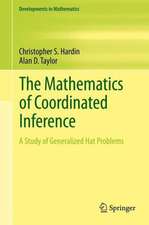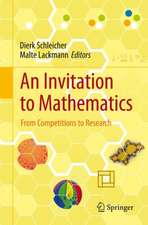Network Models in Population Biology: Biomathematics, cartea 7
Autor E. R. Lewisen Limba Engleză Paperback – 24 noi 2011
Din seria Biomathematics
-
 Preț: 395.09 lei
Preț: 395.09 lei -
 Preț: 385.62 lei
Preț: 385.62 lei -
 Preț: 395.63 lei
Preț: 395.63 lei -
 Preț: 384.48 lei
Preț: 384.48 lei -
 Preț: 398.15 lei
Preț: 398.15 lei -
 Preț: 391.40 lei
Preț: 391.40 lei -
 Preț: 391.02 lei
Preț: 391.02 lei -
 Preț: 402.38 lei
Preț: 402.38 lei -
 Preț: 404.67 lei
Preț: 404.67 lei -
 Preț: 394.51 lei
Preț: 394.51 lei - 15%
 Preț: 704.04 lei
Preț: 704.04 lei - 15%
 Preț: 504.02 lei
Preț: 504.02 lei -
 Preț: 386.22 lei
Preț: 386.22 lei - 15%
 Preț: 654.43 lei
Preț: 654.43 lei -
 Preț: 390.25 lei
Preț: 390.25 lei -
 Preț: 390.63 lei
Preț: 390.63 lei -
 Preț: 405.06 lei
Preț: 405.06 lei - 15%
 Preț: 596.46 lei
Preț: 596.46 lei
Preț: 398.74 lei
Nou
Puncte Express: 598
Preț estimativ în valută:
76.31€ • 79.37$ • 62.100£
76.31€ • 79.37$ • 62.100£
Carte tipărită la comandă
Livrare economică 15-29 aprilie
Preluare comenzi: 021 569.72.76
Specificații
ISBN-13: 9783642811364
ISBN-10: 3642811361
Pagini: 420
Ilustrații: XII, 404 p.
Dimensiuni: 170 x 244 x 22 mm
Greutate: 0.67 kg
Ediția:Softcover reprint of the original 1st ed. 1977
Editura: Springer Berlin, Heidelberg
Colecția Springer
Seria Biomathematics
Locul publicării:Berlin, Heidelberg, Germany
ISBN-10: 3642811361
Pagini: 420
Ilustrații: XII, 404 p.
Dimensiuni: 170 x 244 x 22 mm
Greutate: 0.67 kg
Ediția:Softcover reprint of the original 1st ed. 1977
Editura: Springer Berlin, Heidelberg
Colecția Springer
Seria Biomathematics
Locul publicării:Berlin, Heidelberg, Germany
Public țintă
ResearchCuprins
Why Model?.- 1. Foundations of Modeling Dynamic Systems.- 1.1. Time.- 1.2. Dynamics.- 1.3. State.- 1.4. Discrete and Continuous Representations of Time.- 1.5. The Discrete Nature of Observed Time and Observed States.- 1.6. State Spaces.- 1.7. Progress Through State Space.- 1.8. The Conditional Probability of Transition from State to State.- 1.9. Network Representations of Primitive Markovian State Spaces.- 1.10. Conservation.- 1.11. State Variables Associated with Individual Organisms.- 1.12. Basic Analysis of Markov Chains.- 1.13. Vector Notation, State Projection Matrices.- 1.14. Elementary Dynamics of Homogeneous Markov Chains.- 1.15. Observation of Transition Probabilities.- 1.16. The Primitive State Space for an Entire Population of Identical Objects.- 1.17. Dynamics of Populations Comprising Indistinguishable Members.- 1.18. Deduction of Population Dynamics Directly from the Member State Space.- 1.19. A Situation in Which Member State Space Cannot be Used to Deduce Population Dynamics.- 1.20. The Law of Large Numbers.- 1.21. Summary.- 1.22. Some References for Chapter 1.- 2. General Concepts of Population Modeling.- 2.1. Lumped Markovian States from Irreducible Primitive Markovian State Spaces.- 2.2. Shannon’s Measure: Uncertainty in State Spaces and Lumped States.- 2.3. Lumped Markovian States from Reducible Primitive Markovian State Spaces.- 2.4. Frequency Aliasing: The Artifact of Lumped Time.- 2.5. Idealizations: Thought Experiments and Hypothesis Testing.- 2.6. Conservation: Defining Membership in a Given Population.- 2.7. Conservation and Constitutive Relationships for a Single State.- 2.8. Reproduction, Death and Life as Flow Processes.- 2.9. Further Lumping: Combining Age Classes for Simplified Situations and Hypotheses.- 2.10. The Use of NetworkDiagrams to Construct Models.- 2.11. Basic Principles of Network Construction.- 2.12. Some Alternative Representations of Common Network Configurations.- 2.13. Some References for Chapter 2.- 3. A Network Approach to Population Modeling.- 3.1. Introduction to Network Modeling of Populations.- 3.2. Network Models for Some Basic, Idealized Life Cycles.- 3.3. Scalor Parameters and Multiplier Functions.- 3.4. Time-Delay Durations.- 3.5. Conversion to a Stochastic Model.- 3.6. Some References for Chapter 3.- 4. Analysis of Network Models.- 4.1. Introduction to Network Analysis.- 4.2. Interval by Interval Accounting on a Digital Computer.- 4.3. Graphical Analysis of One-Loop Networks with Lumpable Parameters.- 4.4. Large-Numbers Models with Constant Parameters.- 4.5. Inputs and Outputs of Network Models.- 4.6. Linearity, Cohorts, and Superposition-Convolution.- 4.7. The z-Transform: A Shorthand Notation for Discrete Functions.- 4.8. The Application of z-Transforms to Linear Network Functions.- 4.9. Linear Flow-Graph Analysis.- 4.10. Interpretation of Unit-Cohort Response Functions: The Inverse z-Transform.- 4.11. Types of Common Ratios and Their Significances.- 4.12. The Patterns of Linear Dynamics.- 4.13. Constant-Parameter Models for Nonzero Critical Levels.- 4.14. Finding the Roots of Q(z).- 4.15. Network Responses to More Complicated Input Patterns.- 4.16. Elements of Dynamic Control of Networks.- 4.17. Dynamics of Constant-Parameter Models with Stochastic Time Delays.- 4.18. The Inverse Problem: Model Synthesis.- 4.19. Application of Constant-Parameter Network Analysis to More General Homogeneous Markov Chains.- 4.20. Some References for Chapter 4.- Appendix A. Probability Arrays, Array Manipulation.- A.l. Definitions.- A.2. Manipulation of Arrays.- A.3. Operations on Probability Arrays.- Appendix B. Bernoulli Trials and the Binomial Distribution.















